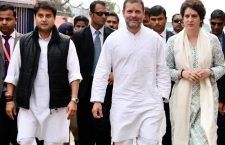Janani Suraksha Yojna, PMJAY & the Cracks in the Maternal Rural Health System: The Case Study of Uma and her Stillborn Child
January 15 marked Makar Sankranti on the festive calendar this year; known as Khichdi locally in Uttar Pradesh, it turned out be anything but celebratory for Shivdevi, a Dalit working woman in Banda, who spent Khichdi ferrying her 37-week pregnant daughter Uma, 20, around, anxious and desperate for medical help. By the day came to a close, Shivdevi had already buried her dead grandchild, and brought a severely ill Uma home. The trauma of what she faced had been so intense that she found herself in absolute shock the next morning, unable to fathom what had unfolded just the previous day, “It’s like my mind is unwilling to cope with the reality. How is it possible that we didn’t get any support anywhere? One thing is certain, “The poor never get what they are entitled to. People like us, we will always fall between the cracks of the government rhetoric, and we will die.”
A week later, we retrace the path that Shivdevi and Uma took on that fateful day, piecing together a horror story of a healthcare system that fails to save those it vouches for, on whose names it makes grand promises.
According to Piyush Goyal’s Interim budget speech in the Parliament on February 1, we have just over a decade left to distress over the state of our healthcare system. ‘By 2030, we will work towards a distress-free healthcare and a functional and comprehensive wellness system for all such a healthy India built with the participation of women having equal rights and concern for their safety and empowerment.’
6400 crores have been sanctioned towards the Pradhan Mantri Jan Arogya Yojana, jauntily known as the ‘PMJAY’. The PMJAY is touted as the world’s largest, most ambitious state-funded insurance scheme, aiming to reach 50 crores of the neediest families in the country. Additionally, over 31,000 crore is the allocation for the National Health Mission, and within that, almost 1600 crore for ‘health and wellness centres’, meant to provide preventive and affordablemedicine to the poorest of the country.
It was one of these very centres that Shivdevi took her daughter to first.After Uma’s complaints of abdominal pain over a few days had failed to cease, Shivdevi decided it was time to seek medical help. She took her to the healthcare sub- centre [a sub centre designated as a delivery point] at Chilla, since it was closest to her, “Lakshmi, the ANM at the Chilla health centre, said there were still three days or so left for the baby to be delivered, and that she couldn’t do anything for her here, so I should take her to Tindwari for blood tests and an ultrasound. That’s all. She saw my daughter who was in pain, she must have known something was wrong,” Shivdevi’s voice shakes with something like anger.
At the Chilla subcentre a week later, there is only scattered bougainvillea. The ANM is absent and the place looks deserted but for the ANM’s mother, who seems to be living there. The ANM told us over a phone call later that she had been suspended three months ago (a case of dubious infant death) and so had not been on duty the day Shivdevi had come to the centre. Could she have met someone else, we ask Lakshmi, who finds the question irritating, ‘If I don’t go there, nobody does.’
Shivdevi, who had by then made several long and futile calls for an ambulance, knew that an ultrasound was imperative.Frustrated and frightened, shehired a private vehicle to take her to the Emergency ward at the district hospital in Banda. Since it was a holiday – Khichdi is very popular in Bundelkhand – the hospital premises, she recalls, were sparsely populated. According to Shivdevi, a staff nurse quickly wrote up a prescription for an ultrasound to be done at a private lab close by – a clear flouting of the patient’s entitlements under the Janani Surakhsha Yojana. The radiologist at the referred-to lab told Shivdevi that the foetus was ‘serious’, and later revealed to the friend accompanying her that the child was in fact, dead. “When I heard that,” said Shivdevi, “panic set in. I stopped being able to hear or understand what people around me were saying.”
Shivdevi’s friend took charge at this point, and the next few hours were a rage-filled blur of doctors, hospitals and hysteria. From amidst the several things they were advised to do that day, Shivdevi clearly recalls one, “Someone told us that the child will come out on its own. Give it 72 hours.”
‘This was a clear case for the women’s hospital, and so we referred the patient there. We can’t handle deliveries in the emergency ward, we are all men,” is Dr. Vipin Sachan’s explanation, when we meet him a week later, whose name was enrolled as ‘on duty’ in the Emergency ward of the district hospital on January 15. Dr. Sachan, also the one who’d made the dubious, not to mention medically incorrect “72-hour” quote,tells us that he knew the foetus was dead when the ultrasound report was shown to him and that he clearly directed the patient and her ‘support-givers’ to the nearby ‘Mahila Hospital’. Amit Mishra, the owner of Bajranga Diagnostic Lab, where Uma got her ultrasound, is quite the matter-of-fact businessman when we meet him a week later, “There is no ultrasound facility in the district hospital after 2pm. They send them all to private labsafter 2 pm.” Mishra, who moonlights as editor of a local news portal, also tells us that there is a dire need for private labs in Banda, “12 have come up, I think, just in the last three years. Radiologists too – there is currently one across the three districts of Banda, Chitrakoot and Mahoba.”
At the women’s hospital, the holiday mood on the fateful day had been even more pervasive, it seemed, and the sparse staff on duty – notably after seeing the ultrasound report that clearly marks the foetal heart rate as ‘absent’– told Shivdevi and her friend that the doctor had actually left for the day, and they should go elsewhere.‘There is no facility to admit her here’, they had said.
No paper trail for this refusal to admit Uma exists, so when we meetthe Chief Medical Officer of Banda, Santosh Mishra, he tells us that it isn’t possible, it couldn’t have happened. “Any case that could not be admitted would be referred to a higher level hospital and the patient would be delivered there by ambulance. That is the protocol,” he insists.
Uma’s stillborn child was ‘delivered’ hours later in a private clinic nearby. The procedure cost her single mother over 30,000 rupees, and there were no neighbourhood ‘Pradhan Mantri Jan Aushadi Kendras’ on hand to help procure ‘affordable medicines’.
“Of course it is the duty of a doctor to admit a patient,”is Dr Sachan’s vehement opinion,“See, I’ve been in this hospital 12 years, and there were 32 doctors when I joined. There are half as many now. People retire, and no new doctors want to be posted in Banda. I’m in the emergency ward, but I also look over orthopedics, since we don’t have a specialist there. And we don’t have any gynaecologists, so all delivery cases are dealt with by the Mahila hospital, where there is 24-hour emergency care available for deliveries.”
Over a fortnight after her encounter with this not-yet-perfect public healthcare system, Uma lieson a charpoy at her mother’s home in Banda district, still deeply distressed, yellowed and convulsed with severe jaundice and pain. Shivdevi’s grandchild, we learn, was buried the night of Khichdi itself, and we collectively shudder in the thick aura of pall and gloom that hangs over the sunny aangan. Just out of eyesight, Uma’s husband, on a tense leave of absence from his job on a construction site in Nangloi, Delhi, watches his wife’s tender belly.
As factions rejoice over sanctions of huge funds towards a healthcare system, there lies buried the tiny body of a Dalit child in the Banda cemetery. “I don’t even remember if it was a girl or a boy”, says Shivdevi, as she glances at a frail Uma, perhaps fearing the worst is yet to come.
An edited version of this Khabar Lahariya article first appeared on Scroll.

